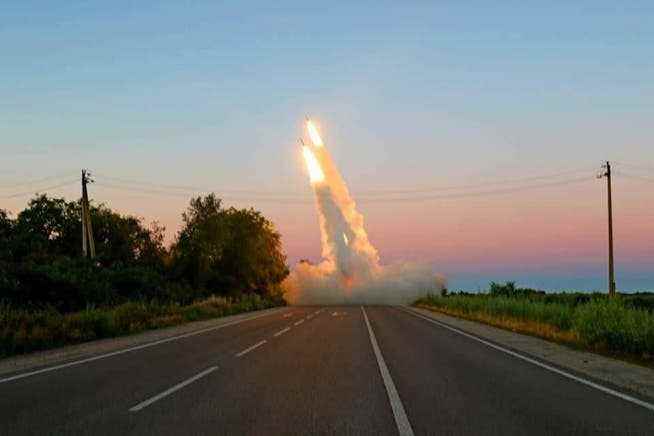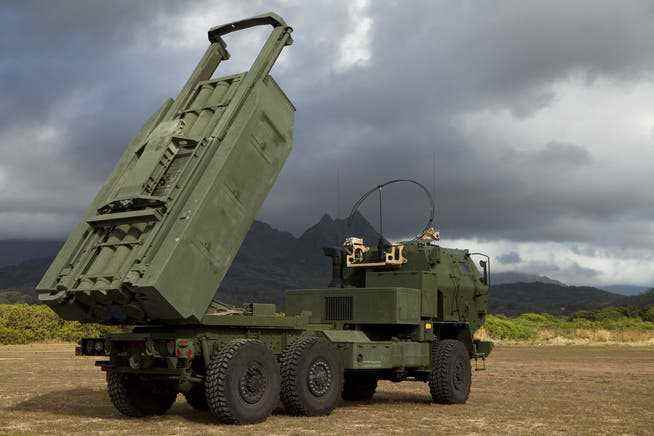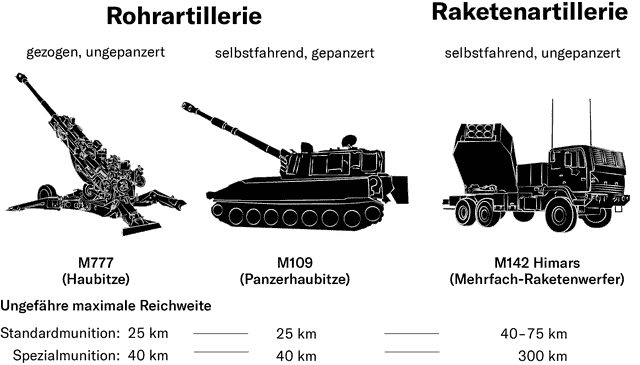Strong artillery superiority has enabled the Russians to make a slow but steady advance in eastern Ukraine. In order to disrupt Russian ammunition supplies, the Ukrainians must be able to attack far behind the front lines.
The explosion at Nowa Kachowka’s ammunition depot after a Himar rocket launcher attack left widespread destruction in its wake.
It happened in the town of Nowa Kakhovka in the Russian-occupied Kherson region of southern Ukraine heavy explosions on Tuesday night. According to Russian television, these were so violent that window panes broke within a two-kilometer radius. Numerous recordings published on social networks documented the incident.
The Ukrainian military then spoke of an attack on a Russian ammunition depot, in which numerous military material was destroyed and more than fifty soldiers were killed. The Russian occupation authorities, however, reported an attack on apartments and fertilizer warehouses in which at least seven people were killed and many injured. However, the two sides agreed that the attack had been carried out with American M142 Himars (High Mobility Artillery Rocket System) multiple rocket launchers, which have been in use in Ukraine since the end of June.
Ukraine hit a major Russian weapons depot tonight in Nova Kahovka.
HIMARS in action.
— Visegrad 24 (@visegrad24) July 11, 2022
In the past few days, the Ukrainian army has also carried out numerous rocket attacks in occupied Donbass. A spokesman for the separatists spoke of mass shelling by Himar. The Ukrainian side confirmed the use of the multiple rocket launcher against ammunition depots. Leonid Pasechnik, head of the “Luhansk People’s Republic” recognized by Russia, said the American Himars threatened his “state”. Fortunately, Ukraine does not have many such weapons, so there is no reason to panic.
The aforementioned incidents followed a string of similar attacks on Russian ammunition depots in recent weeks. Already on July 4, the Washington think tank Institute for the Study of War found that the Ukrainian military was succeeding in attacking more and more military infrastructure behind the Russians with Himars. Ammunition depots were hit up to 75 kilometers behind the front.
Massive Russian artillery superiority
News of the successful deployment of the M142 brings new hope to Ukraine’s counter-attack against the Russian aggressor, after the latter has managed to make slow but steady advances in Donbass over the past two months. The Russian armed forces owed this in particular to their great superiority in artillery (experts speak of a ratio of 10:1).
Russian attack tactics rely on massive area fire from guns. Before advancing, entire cities or defensive positions in the countryside are subjected to massive shelling for days or even weeks until only ruins remain and the enemy, who has lost cover, has to retreat. The attacking troops are then sent forward to take over the devastated area.
The British Royal United Services Institute for Defense and Security Studies estimates that that the Russians are currently firing an average of 20,000 152mm shells per day, compared to about 6,000 shells by the Ukrainians. Recently, Ukraine has found it increasingly difficult to keep up with the Russians due to limited ammunition supplies. Ukraine is running out of Soviet-era 152mm ammunition and supplies from neighboring countries in Eastern Europe are limited. The 155 mm ammunition from the west also has to be transported into the country, which is a laborious and time-consuming process, since the transports are exposed to attacks from Russian short-range missiles or cruise missiles.
The Russians, on the other hand, have almost unlimited supplies of Soviet-era ammunition throughout the country and can also continue to produce the shells in large numbers. Experts believe that the Russian army could maintain the current rate of ammunition consumption for several years. However, she has to get the grenades over long distances from Russia to Ukraine, which is mainly done by rail.

Launching of rockets from a Himar rocket launcher in southern Ukraine near Zaporizhia (photo by the Ukrainian General Staff).
Himars can severely disrupt supplies
But this is exactly where the Himars can play a key role. If the rocket launchers can reach targets 75 kilometers behind the front, that means the Russians will have to offload the ammunition from the train and truck it on nearly 100 kilometers to the front, if they want to forestall attacks. This took considerably more time. The trucks would also need to be better camouflaged as they can also be targeted. Large depots would also have to be set up outside the reach of the Himars. Ukraine cannot drastically increase its ammunition supply, but with the Himars, it could substantially reduce the Russian ammunition supply, creating a less uneven playing field.
However, the number of twelve units announced by the Americans is certainly not enough. For effective defense, Ukraine needs several dozen more Himars. In addition, it would be very helpful for the Ukrainian army if they also received Atacms short-range missiles, which can also be fired with the Himars and can accurately target targets up to 300 kilometers away. The Russian supply of ammunition could be disrupted much better in this way. The Americans have not yet delivered such missiles, fearing an escalation as a result of Ukrainian attacks on Russia.
Western guns are more accurate and shoot farther
The western artillery technology can also oppose the Russian mass bombardment due to its higher quality. Western guns and missiles are generally superior to Russian ones in terms of accuracy and range. Depending on the type of ammunition, the towed American M777 howitzer has a range of 22.5 to 30 kilometers, with laser-guided Excalibur special ammunition it is even 40 kilometers. The comparable Russian 2A65 Msta-B howitzer only has a maximum range of 28.5 kilometers.
Also, the German Panzerhaubitze 2000, of which Ukraine received a small number, with a maximum range of 40 kilometers surpasses the most commonly used Russian self-propelled guns 2S3 Akatsiya and 2S19 Msta-S, which with special ammunition reach a maximum of 24 and 29 kilometers, respectively.
In addition, the west has ammunition that can be precisely guided on the trajectory. This applies both to the Excalibur ammunition for the 155 mm howitzers and to the rockets fired by Himars. The Russians also have precision-guided ammunition, but these make up only a small part of their arsenal. In addition, there seems to be a lack of appropriately trained soldiers. So it is even said that the Russians fire expensive precision ammunition like normal grenades without laser control.
Logistical issues due to too many weapon types
In the past arms aid to Ukraine, the West has supplied many different types of weapons in small numbers. As a short-term emergency measure after the Russian attack, this was probably not possible otherwise. But because the war is likely to last for months or even years, it would be important for the Ukraine to be supplied with the smallest possible number of types, but with larger numbers.
The fragmentation into numerous different weapon systems that fulfill the same function is logistically very demanding and therefore inefficient. For example, in the case of self-propelled artillery pieces, German tank howitzers 2000, American M109s and French Caesars were supplied, all in single-digit or low double-digit numbers. This requires different training of soldiers for each gun, each type of weapon needs different spare parts and specialized weapons mechanics for maintenance.
Only the M777 towed howitzer has so far been supplied in large numbers by the West – around 100 guns, mainly by the Americans. With such a number, the deployment is much more efficient. For comparison: the entire Swiss army still has about the same number of mobile artillery pieces in use today (M109 Kawest self-propelled howitzers). In 1995, before the sharp reduction after the end of the Cold War, there were almost 800 towed and self-propelled guns of just two types (plus over 100 modern, permanently installed fortress artillery pieces distributed at key points across the country, all of which have since been mothballed).

Using standard ammunition, the M142 Himars fires up to 75 kilometers with great accuracy.
This is another reason why a delivery of additional Himars would make sense instead of delivering other types of multiple rocket launchers. In response, the Russians would have to try to find more weapons and ammunition depots and attack them with their rockets – a discipline in which the Ukrainians have shown superiority of late.

